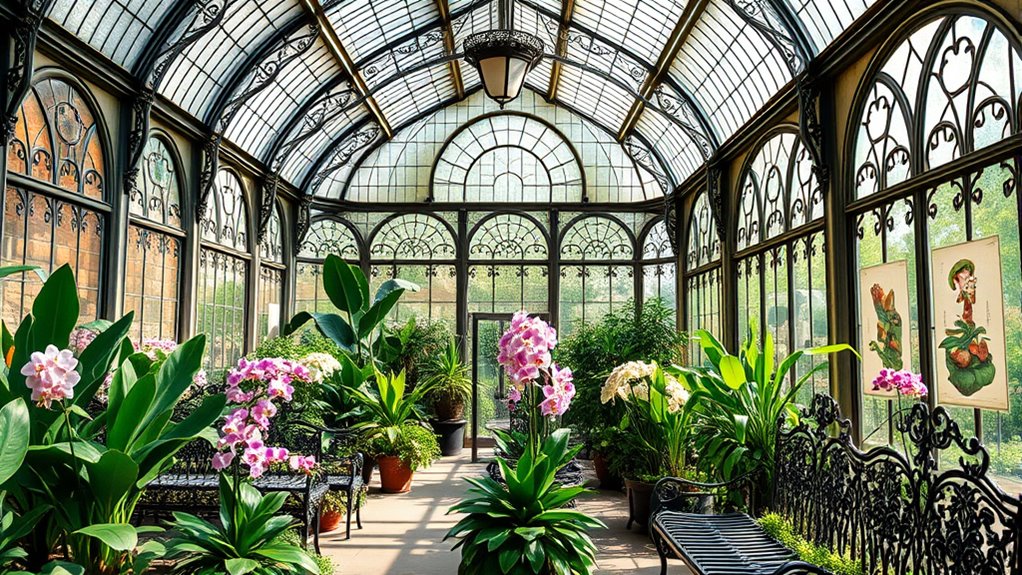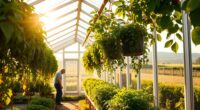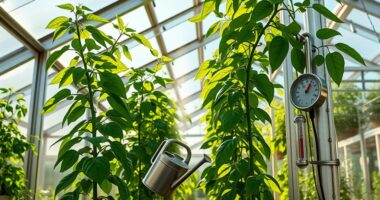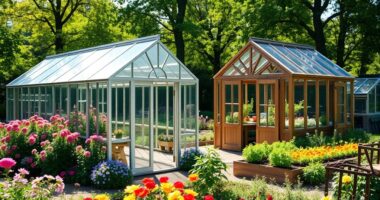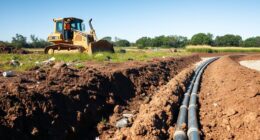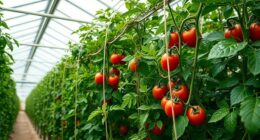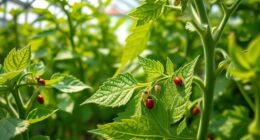Greenhouses date back to ancient civilizations where early experiments in controlled environments and plant domestication took place. Over time, innovations like glass and stronger materials in Medieval and Renaissance Europe allowed larger, clearer structures. The Industrial Revolution brought mass production, enabling modern, larger greenhouses with advanced climate control. Today, smart technology, automation, and sustainable designs make greenhouses more efficient and eco-friendly. Explore further to discover how these developments transformed agriculture and horticulture worldwide.
Key Takeaways
- Greenhouses evolved from ancient irrigation, plant domestication, and weather protection techniques to controlled environment experiments.
- Medieval and Renaissance Europe saw the development of glass greenhouses, enabling exotic plant cultivation and scientific research.
- The Industrial Revolution introduced mass-produced glass and steel, resulting in larger, more durable, and architecturally integrated greenhouses.
- Modern greenhouses incorporate automation, climate control, hydroponics, and sustainable designs to optimize plant growth and resource efficiency.
- Today, greenhouses support year-round agriculture, urban farming, and ecological sustainability through advanced technology and innovative materials.
Early Innovations in Ancient Civilizations
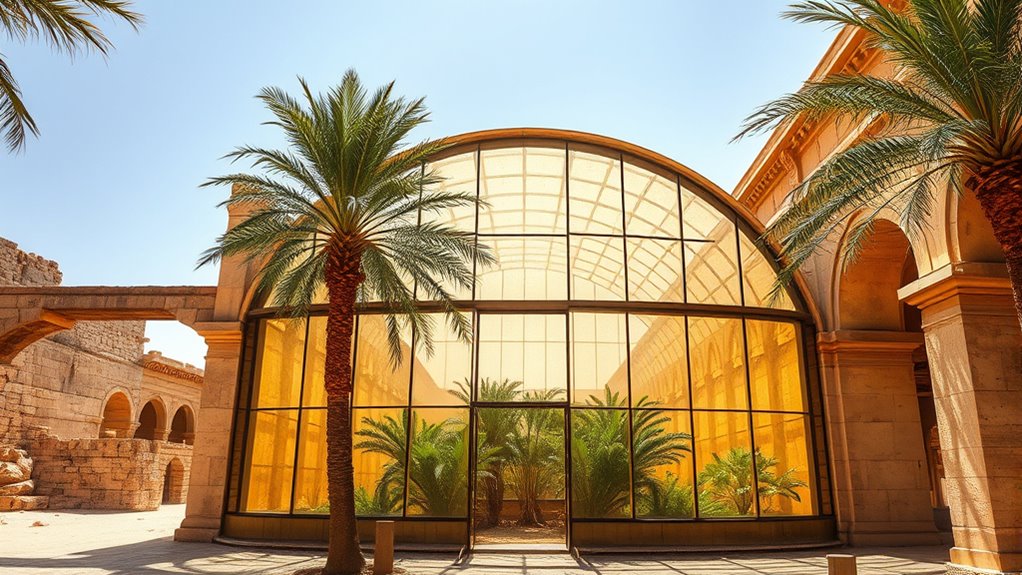
Ancient civilizations laid the groundwork for greenhouse development by experimenting with ways to grow plants in controlled environments. They mastered ancient irrigation techniques to efficiently water crops, which helped sustain agriculture in dry regions. Early plant domestication was essential, as people selectively cultivated species for better yield, taste, and resilience. These innovations allowed civilizations like Mesopotamia, Egypt, and China to thrive by managing their food supply more effectively. By developing methods to protect plants from harsh weather and pests, they laid the foundation for future greenhouse concepts. Additionally, their agricultural innovations demonstrate an understanding of environmental manipulation that contributed to the evolution of controlled cultivation techniques. These early efforts also reflected a desire to increase crop productivity and ensure food security, which are core principles behind controlled environment agriculture. The use of simple structures and techniques to modify microclimates was an early form of environmental control that has evolved into modern greenhouse technology. Although simple compared to modern structures, these early efforts demonstrated a desire to control growing conditions, setting the stage for more advanced techniques centuries later. Moreover, these innovations highlight the importance of microclimate management in sustainable agriculture. Your understanding of this history highlights how innovation in agriculture has always been indispensable for human progress.
The Development of Glass and Its Impact
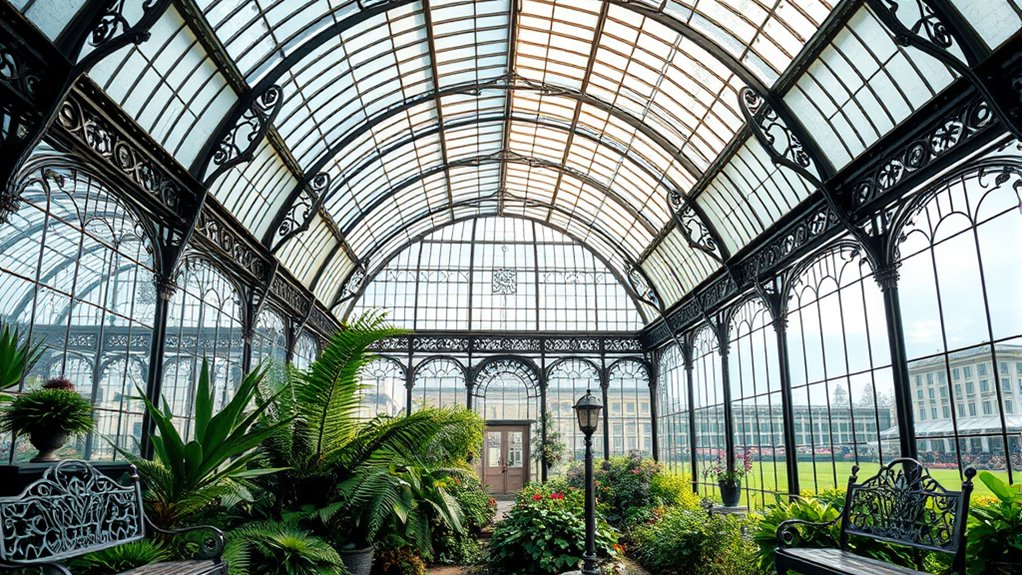
The development of glass revolutionized greenhouse construction by providing a transparent material that lets in sunlight while protecting plants from harsh weather. As glass development progressed, its transparency evolution allowed for clearer, stronger, and more durable panes. This advancement meant you could create larger, more efficient greenhouses, maximizing light exposure and plant growth. Early glass was often thick and uneven, but innovations improved clarity and strength, reducing heat loss and increasing longevity. These improvements made greenhouses more accessible and practical, enabling year-round cultivation. The ability to control the environment better, thanks to advanced glass, transformed agriculture and botanical studies. Additionally, fostering creativity in design and experimentation has led to continuous improvements in greenhouse technology. Today, modern glass continues to evolve, blending transparency with energy efficiency, shaping the future of greenhouse technology. The ongoing development of glass technology ensures that greenhouses will continue to become more sustainable and effective for diverse agricultural needs.
Greenhouses in Medieval and Renaissance Europe

As advancements in glass technology improved greenhouse construction, their influence reached medieval and Renaissance Europe, where the concept of controlled plant environments began to take shape. During medieval horticulture, wealthy monasteries and estates built simple glass structures to grow exotic plants and herbs, showcasing status and knowledge. These early greenhouses often used basic materials like wood and glass, laying the groundwork for more sophisticated designs. Renaissance architecture further refined these designs, integrating large windows and ornate frameworks that reflected the era’s aesthetic ideals. Greenhouses became symbols of innovation and prestige, allowing gardeners to cultivate delicate plants out of season. Although these early structures lacked the sophisticated climate control of modern greenhouses, they marked a vital step in advancing plant cultivation and understanding environmental manipulation. This period set the foundation for more complex horticultural pursuits in the centuries to come, with the development of environmental control techniques that would eventually revolutionize greenhouse design. Additionally, the influence of architectural aesthetics played a significant role in shaping the grandeur and functionality of these structures. The use of glass technology was instrumental in improving the durability and transparency of greenhouse coverings, enabling better light transmission for plant growth.
The Rise of Botanical Gardens and Their Greenhouses

During the 16th and 17th centuries, botanical gardens emerged as centers of scientific exploration and horticultural innovation, fueled by a growing curiosity about plant diversity worldwide. You become involved in building impressive plant collections that showcase exotic species, advancing botanical research. These gardens serve as living laboratories, allowing scientists and horticulturists to study plant physiology, taxonomy, and adaptation in controlled environments. Greenhouses within these gardens enable the cultivation of delicate or non-native species, supporting ongoing research and education. The integration of data-driven marketing strategies and technological advancements further enhanced the development and dissemination of botanical knowledge. Additionally, the use of innovative gardening tools, such as specialized planters and watering systems, improved plant care and research efficiency. As you explore these gardens, you witness firsthand how they transform from mere collections into essential hubs for scientific discovery. Their development marks a significant step in the history of greenhouses, blending aesthetic beauty with practical function to deepen our understanding of plant life. Modern innovations like climate control systems and greenhouse automation have further revolutionized botanical research and cultivation. Moreover, advances in environmental control enable precise regulation of temperature, humidity, and light, optimizing growth conditions for diverse plant species, which further underscores the importance of controlled environments in modern botany.
The Industrial Revolution and Technological Advancements

The Industrial Revolution sparked a wave of technological innovations that revolutionized greenhouse construction and design. You see, this era introduced mass-produced glass and steel, making greenhouses larger and more durable. With these advances, urban farming became more viable, allowing city dwellers to grow fresh produce in confined spaces. Additionally, the development of emotional support strategies for urban growers helped them manage the stresses of modern gardening practices and environmental challenges. Decorative structures also flourished, transforming greenhouses into stunning architectural features. You might imagine:
- Larger, more efficient glass panes for better light transmission
- Steel frameworks providing stronger, taller structures
- Ventilation systems improving temperature control
- Use of coal and later electricity to automate climate regulation
- Integration of decorative elements to enhance aesthetic appeal
These innovations made greenhouses more accessible and functional, shaping modern urban farming and stylish, decorative structures that blend utility with beauty. Furthermore, the advent of structural materials like reinforced glass and steel contributed to the durability and versatility of greenhouse designs, allowing for more ambitious and innovative architectural projects. Additionally, advances in climate control technology allowed for year-round cultivation, greatly expanding the possibilities for plant growth in various environments.
The Emergence of Modern Greenhouse Design and Automation
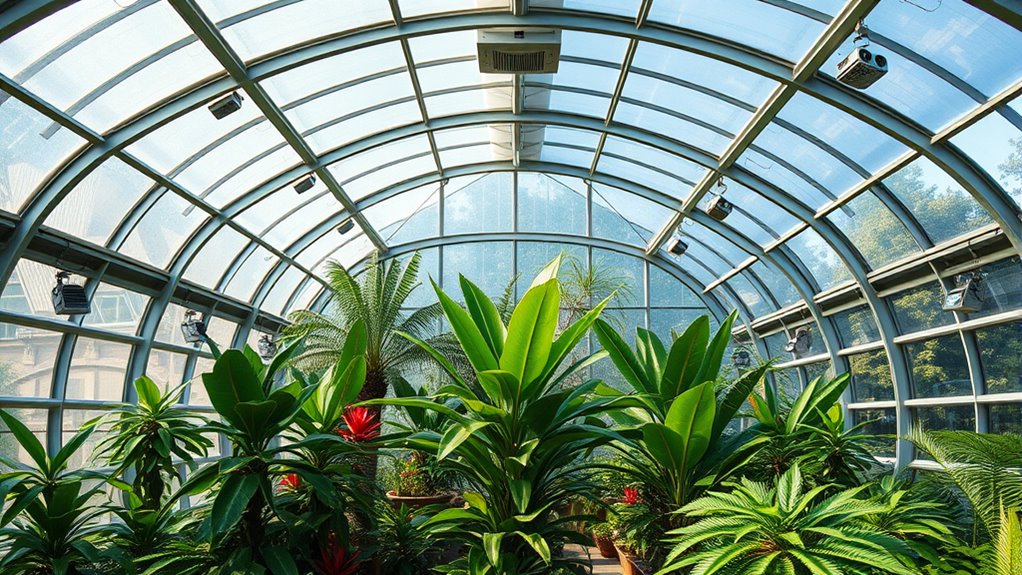
Advances in materials and technology have transformed greenhouse design into a highly automated and efficient system. Modern greenhouses now incorporate hydroponic systems that enhance plant growth without soil, and automated irrigation that conserves water while maintaining ideal moisture levels. These innovations streamline operations and boost productivity. Here’s a quick look at key features:
| Feature | Benefit |
|---|---|
| Transparent Polymers | Increased light transmission and durability |
| Automated Ventilation | Precise climate control and energy efficiency |
| Hydroponic Systems | Faster growth and higher yields |
| Automated Irrigation | Water conservation and reduced labor |
| Sensor Technology | Real-time monitoring for optimal conditions |
These advancements make greenhouses smarter, more sustainable, and easier to manage.
Innovations in Climate Control and Energy Efficiency
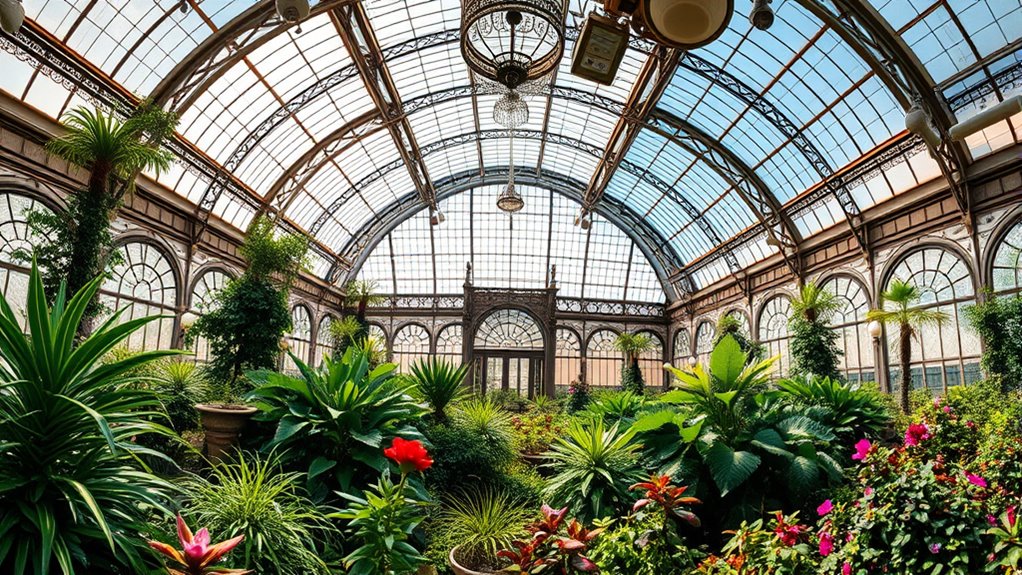
Innovations in climate control and energy efficiency have revolutionized greenhouse management, allowing you to maintain ideal conditions with minimal energy use. Modern techniques include advanced solar shading systems that reduce heat gain during hot days, helping you save on cooling costs. Ventilation systems now operate more efficiently, providing fresh air and regulating humidity without wasting energy. Incorporating insulation techniques further enhances energy efficiency by reducing heat loss and maintaining stable internal temperatures. Automated controls optimize temperature and light, ensuring plants thrive without constant manual adjustments. These innovations create a stable environment, even in unpredictable weather. You can also harness passive solar design features, like strategic glazing placement, to maximize natural light while minimizing heat loss.
Contemporary Greenhouse Technologies and Future Trends

Contemporary greenhouse technologies are transforming how you grow plants by integrating smart systems and sustainable designs that enhance productivity and reduce environmental impact.
You now have access to advanced hydroponic systems that enable soil-free cultivation, increasing efficiency and crop yields in limited spaces.
Vertical farming, another innovation, stacks crops vertically, maximizing land use and allowing year-round production in urban areas.
These technologies utilize automation, sensors, and data analytics to optimize climate control, watering, and nutrition, minimizing resource waste.
As a result, you can achieve faster growth cycles and higher quality produce with less energy input.
These innovations are shaping the future of greenhouse agriculture, making it more sustainable, scalable, and adaptable to global food demands.
The Role of Greenhouses in Sustainable Agriculture
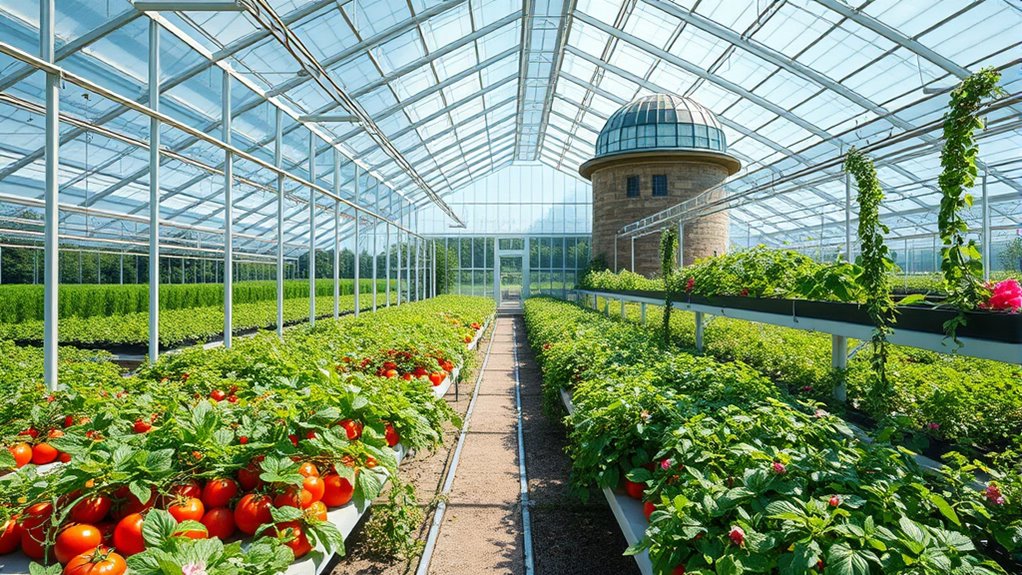
Greenhouses play an essential role in promoting sustainable agriculture by enabling efficient food production with minimal environmental impact. They allow you to grow crops year-round, reducing the need for long-distance transportation and lowering carbon footprints.
In urban farming, greenhouses maximize limited space, supporting vertical gardening that boosts yield in small areas. They also help conserve water through controlled irrigation systems and reduce pesticide use by creating a protected environment.
With energy-efficient designs, greenhouses cut down on resource consumption and support renewable energy integration. Their versatility makes them ideal for community gardens, local food systems, and reducing food miles.
Frequently Asked Questions
How Did Ancient Cultures Originally Source Materials for Their Early Greenhouses?
You might wonder how ancient cultures sourced materials for their early greenhouses. They relied on local resources for early construction, using materials like stone, clay, and wood readily available in their surroundings.
These civilizations gathered natural elements from their environment, often repurposing materials or utilizing native plants and transparent substances like animal skins or glass, to create structures that protected plants and extended growing seasons.
What Were the Key Challenges Faced During the Transition From Glass to Modern Greenhouse Materials?
You face challenges like glass durability and material costs when shifting to modern greenhouse materials. Modern materials need to be sturdy enough to withstand weather, yet affordable for widespread use.
You also consider how to balance transparency for sunlight with insulation. These factors push innovation, leading to the development of durable, cost-effective alternatives like polycarbonate and specialized glass.
These advancements improve greenhouse efficiency and durability over time.
How Have Cultural Perceptions Influenced Greenhouse Design Throughout History?
You see that cultural perceptions shape greenhouse design considerably. Cultural symbolism influences the materials and structures you choose, reflecting local values and traditions.
Aesthetic preferences drive you to design greenhouses that blend with or stand out in their environment. These cultural factors guarantee greenhouses aren’t just functional but also embody the artistic and symbolic meanings of the society, making them a reflection of cultural identity throughout history.
In What Ways Did Global Trade Impact the Spread of Greenhouse Technology?
Imagine bustling trade routes connecting distant lands, where cultural exchange sparks innovation. You see how greenhouse technology spreads across continents, evolving with each new idea.
Global trade ignites this transfer of knowledge, allowing innovations in design and materials to travel far beyond their origins. This exchange accelerates advancements, making greenhouses more efficient and accessible worldwide, transforming agriculture and horticulture as you know it today.
What Are the Most Significant Environmental Impacts of Historical Greenhouse Practices?
You should consider that historical greenhouse practices often had significant environmental impacts. These included energy consumption for heating, which increased carbon emissions, and the use of non-sustainable materials that harmed ecosystems.
While some innovations aimed at sustainable practices, many ecological consequences resulted from intensive resource use. Recognizing these impacts helps you understand the importance of adopting more environmentally friendly methods today to reduce ecological harm.
Conclusion
Greenhouses have transformed drastically, shaping how we grow plants and sustain our environment. From ancient glass innovations to cutting-edge automation, they’ve continually evolved to meet our needs. As you consider their future, ask yourself: can we harness this technology responsibly to nurture our planet and future generations? Greenhouses aren’t just structures; they’re essential tools in securing a sustainable, thriving world. Will you be part of that positive change?
